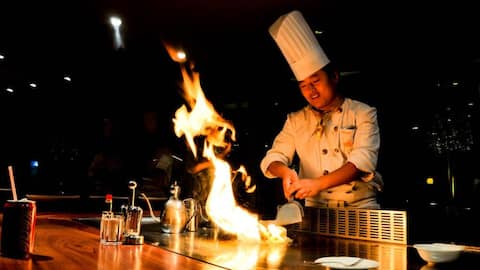Griddle goals: Demystifying the artistry of teppanyaki
What's the story
Teppanyaki cooking is more than just a culinary technique; it's a spectacle that combines skillful craftsmanship with the freshest and finest ingredients. Originating in Japan, teppanyaki has evolved into a globally renowned dining experience, captivating diners with its theatrical presentation and mouthwatering flavors. Join us as we uncover the essence of teppanyaki—a traditional Japanese culinary art form celebrated for its precision and theatricality.
About teppanyaki
What is teppanyaki?
The term "teppanyaki" derives from two distinct components: "teppan," referring to the iron griddle or plate, and "yaki," indicating grilling or cooking. Collectively, it signifies dishes grilled or cooked on a griddle. In Japan, teppanyaki encompasses various dishes prepared on a griddle, such as yakisoba (fried noodles) or monjayaki (a savory dough with assorted ingredients, akin to melted cheese in texture).
Teriyaki and Teppanyaki
Difference between teriyaki and teppanyaki
These two cooking methods are often confused due to their similarities, primarily their use of the griddle for cooking. However, the key difference lies in the sauce: teriyaki uses a unique blend of soy sauce, sugar, mirin (sweet rice wine), and sake (rice wine), which is heated until it thickens. The food is then marinated in this sauce before being cooked on the griddle.
Types of food
Sauteed vegetables
Teppanyaki cuisine is renowned for its emphasis on precision cutting, a technique essential for achieving perfect cooking in a short time frame, without any risk of burnt flavors. Fresh vegetables like leeks, broccoli, mushrooms, cherry tomatoes, zucchini, lettuce are mostly served with rice or noodles. The vegetables are lightly sauteed and stewed in a sauce and special seasonings that accumulate on the griddle.
Interactive experience
Show of skill
Skilled chefs command spatulas and knives with precision, captivating guests with dazzling culinary performances. Beyond mere cooking, teppanyaki chefs often display their creativity by arranging ingredients into intricate designs or shapes on the grill. From seamlessly transferring food directly from the cooking surface into guests' mouths to crafting fiery volcanoes and expertly cracking eggs mid-air, these chefs elevate mealtimes into an interactive experience.
